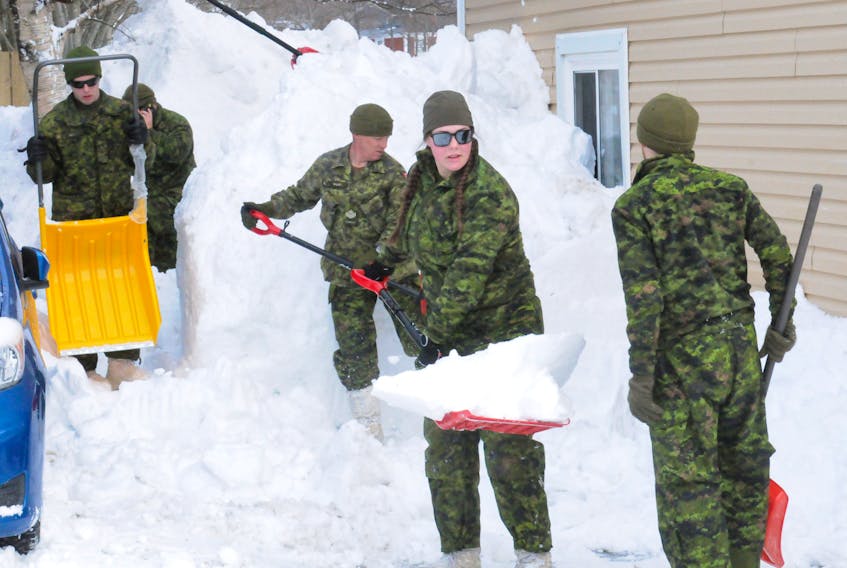Newfoundland and Labrador spends less on preparing for emergencies than any other province in Atlantic Canada, with the provincial emergency services budget quietly dropping by nearly a third over the last decade.
The monster blizzard that walloped eastern Newfoundland two weeks ago with powerful winds and record-breaking snowfall prompted an eight-day state of emergency in St. John’s and the deployment of hundreds of soldiers.
Heartwarming stories emerged from the depths of the so-called Snowmageddon. Neighbours rallied to help each other, and first responders like snow plow operators, utility workers and firefighters worked tirelessly in the face of unrelenting wind and snow.
But the historic storm also exposed what some experts say is a lack of emergency preparedness in Canada’s easternmost province.
An investigation by the SaltWire Network reveals that despite warnings that climate change will bring more frequent and intense storms, Newfoundland’s budget for emergency management has fallen over the last several years.
For the current fiscal year, Newfoundland’s Emergency Services Division budget is set at $603,000 — a nearly 30 per cent drop from the $848,500 budgeted in 2011-2012, according to estimates on the government’s website.
It’s the smallest budget of all four Atlantic provinces: Prince Edward Island’s Emergency Measures Organization budget is $652,500, while Nova Scotia’s Emergency Management Office has a $2.2 million budget and New Brunswick’s Emergency Measures Organization is $3.4 million.
Broken down per person, the spending gap is more pronounced.
On a per capita basis, Newfoundland spends about $1.19 for every resident. Nova Scotia spends nearly double at $2.30 per person, while P.E.I. spends about $4.27 and New Brunswick $4.47.
“It's alarming, I think, for a province of this size. Certainly, when you compare it to neighbouring provinces with similar conditions, it looks to me that there needs to be a change or modification.”
- Ali Asgary, associate professor of disaster and emergency management at York University in Toronto

It’s not that the province is poorer, smaller or gets fewer storms.
Newfoundland’s gross domestic product per capita is higher than every other Atlantic province at about $63,243 — about 35 per cent more on average than the three other provinces in the region.
It’s also the biggest province in the region, with its total land area measuring 373,872 square kilometres, according to Statistics Canada. That’s almost three times the size of Nova Scotia, New Brunswick and P.E.I. combined.
And Newfoundland is no stranger to bad weather and severe storms.
According to the Canadian Disaster Database, which tracks significant disaster events across the country, Newfoundland has had 74 natural disasters since 1900. Nova Scotia has had 67, while New Brunswick 91 and P.E.I. 43.
Ali Asgary, associate professor of disaster and emergency management at York University in Toronto, said the budget appears insufficient.
“It's alarming, I think, for a province of this size,” he said in an interview. “Certainly, when you compare it to neighbouring provinces with similar conditions, it looks to me that there needs to be a change or modification.”

Municipal Affairs and Environment Minister Derrick Bragg, who oversees the province’s Emergency Services Division, said overall the provincial response to the blizzard was a success.
“If I had to relive it all over again, I don’t think we would change a lot,” he said in an interview Friday, noting that the decision to shut down government offices and institutions ahead of the storm helped keep traffic off the roads and people safe.
Still, Bragg said the province is conducting an ongoing debrief with provincial departments and municipalities to assess the province’s response to the storm.
With climate change expected to usher in more frequent, fierce storms, experts say the province should beef up its emergency preparedness, mitigation and adaptation measures.
For example, Asgary called the province’s emergency management plan, last revised in 2014, “a very basic document” that needs updating.
Meanwhile, it took three days for the province to open its emergency operations centre after the blizzard hit Newfoundland — a delay some observers say may have hindered the timely co-ordination of resources and communication with the public.
It’s in stark contrast to other provinces.
'It's about being proactive'
New Brunswick usually opens its emergency operations centre three days before spring flooding is expected, said Geoffrey Downey, a spokesman for New Brunswick’s Emergency Measures Organization. In the case of hurricane Dorian, it opened when the storm was still in the Boston area, he said.
Nova Scotia’s EMO also opened its provincial co-ordination centre before Dorian’s arrival. It began operations the morning of Saturday, Sept. 7. Dorian made landfall in the Halifax-area shortly after 7 p.m. that night as a post-tropical storm.
It reflects a trend across North America to open emergency operations centres ahead of impending storms.
“Instead of waiting for the event to happen and then activating emergency operations centres as needed, the trend in weather-related emergencies that can be predicted is to open before the storm,” Asgary said.
“It’s about being proactive rather than waiting for the storm to hit.”
Asgary said there are multiple reasons for this, including ensuring staff can reach the operations centre before the roads become impassable, as well as having a central hub for communication throughout the storm.
“You can be weak in the organizational capacity and response, or you can be as strong as possible. None of that will preclude the need at the end of the exercise for a debrief to look for gaps and lessons learned.”
- Fred Hollett, co-chief of the Portugal Cove-St. Philip’s Fire Department

Indeed, Bragg said the operations centre wasn’t opened until the worst of the storm had passed “because physically we could not drive throughout this city.”
He acknowledged this delay may have contributed to what critics have called the lack of a clear, co-ordinated voice from the government during the storm.
Although there was a flurry of social media posts, media availabilities and public advisories from various officials and departments throughout the storm, there was no overarching official point of contact.
For example, the provincial government did not issue an official press release for one week after the storm began. In one instance, this caused the province’s health minister to say pharmacies would open, while the City of St. John’s said they would remain closed.
“I know people look back and say one of our weaknesses was our ability to put out news releases,” Bragg said.
But he added that the province was in constant contact with “the people who needed to know” throughout the storm, including the municipalities and the media.
Still, observers question whether a lack of staff in the Emergency Services Division may have hampered operations. The branch has nine employees.
In comparison, P.E.I.’s emergency organization has seven employees — though the province’s population is less than a third of Newfoundland — while Nova Scotia has 25 positions and New Brunswick has 36, including 10 contract employees.

'Better adaptive capacity'
Yet Kevin Quigley, a professor in the School of Public Administration at Dalhousie University, questioned calls to simply spend more money or add staff.
“It’s not necessarily about bigger budgets and bigger staff,” said Quigley, the director of the MacEachen Institute for Public Policy and Governance.
“From a risk point of view, how much money do you spend on events that don't happen very often,” he said. “This is such an unusual situation. Storms of that magnitude … just don't happen very often.”
Quigley said it’s about “better adaptive capacity” and becoming more “resilient, adaptive and flexible.”
Fred Hollett, former fire commissioner and director of emergency management for the province, said the coming weeks and months will be critical.
Although he said the government is never going to “check every box” or satisfy everyone, he said it’s important to “sit back now and have a second look at how we did.”
“You can be weak in the organizational capacity and response, or you can be as strong as possible,” said Hollett, co-chief of the Portugal Cove-St. Philip’s Fire Department.
“None of that will preclude the need at the end of the exercise for a debrief to look for gaps and lessons learned.”
RELATED:
- Tipping a hat to those who stood through the Newfoundland storm
- 'Incredible, incredible what happened' Eastern Health says of staff dedication in Blizzard 2020
- LETTER: A salute to snow-shovelling soldiers
- Digging out from a dark storm, under sunny Sunday skies
- Military personnel have shovels hitting the snow to help St. John's recover from blizzard
- Residents of Mount Pearl, Paradise and C.B.S. dig in, and out









